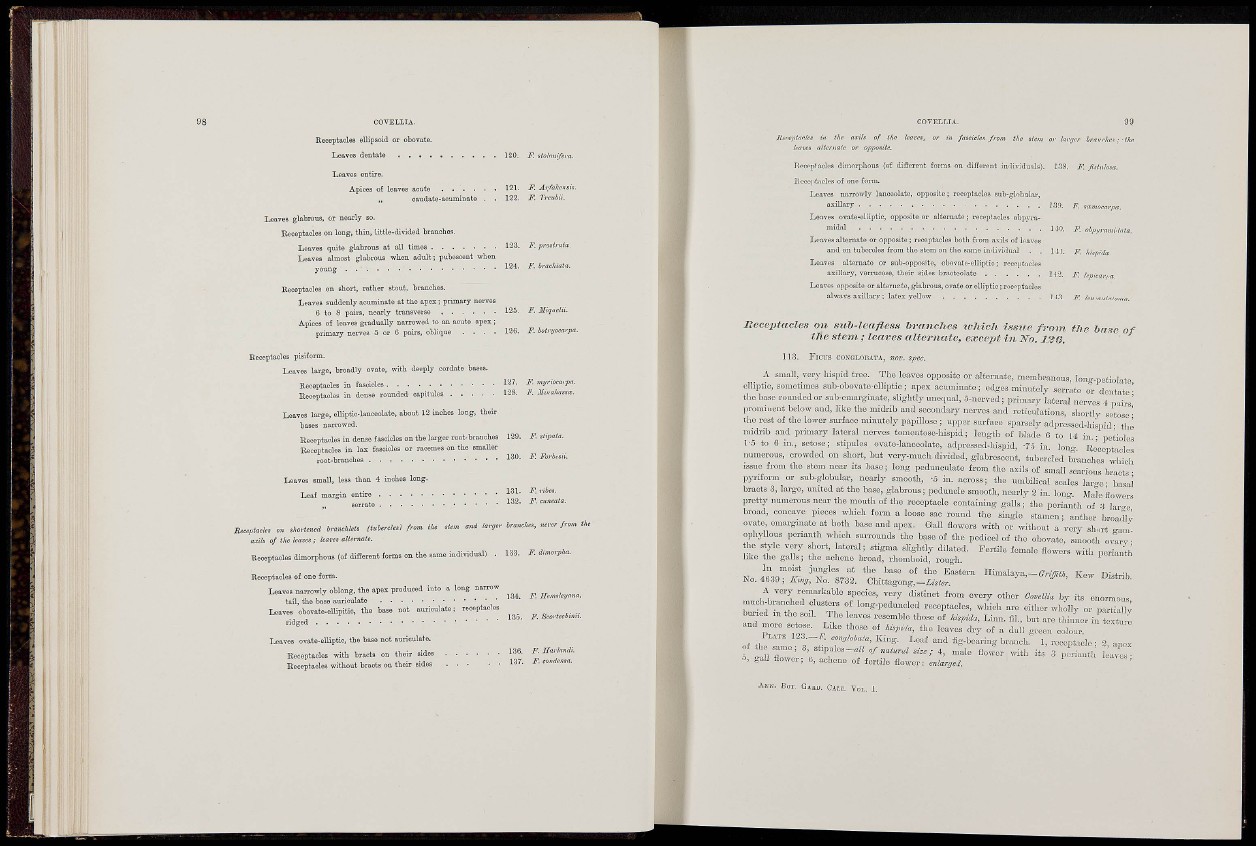
ellipsoid or obovate.
Leaves dentate . . . .
Leaves entire.
120. F. stolonifera.
Apices of leaves acute
„ caudate-acuminate . .
Leaves gla"brous, or nearly so.
Receptacles on long, thin, little-divided branohes-
Leaves (^uite glabrous at all times
Loaves almost glabrous when adult; pubescent wlien
youog
121. F. A>:M-oiisis.
122. F. Trcubii.
123. F. prodmta
124. F. hi-achiata.
Receptacles on short, rather stout, branches.
,s suddenly acuminate at the apex; primary nerves
5 to 8 pairs, nearly transverse 125. F. Miquelii.
.ices of leaves gradually narrowed to an acute apes;
primai'y nerves 5 or 6 pairs, oblique . . . . 126. F. botnjocarpa.
Receptacles pisiform.
Leaves large, broadly ovate, with deeply cordate bases.
Eeceptacles in dense rounded capitules
127. F. imjríocarpa.
128. F. Minahusace.
Leaves large, eUiptic-lan ce oíate, about 12 inches long, theii
bases narrowed.
Receptacles in dense fascicles on the lai'ger root-bran ches 129. F. slipata.
Eeceptacles in lax fascicles or racemes on the smaller
root-branches 130. R Forb.m.
Leaves Bmall, less than 4 inches 1
Leaf margin entire . . . • 131. F. ribes.
132. F. ameata.
shortened branchkis (tubercles) from the stem and larger
axils of the leaves; leaves alUrnate.
Ueceptacles dimorphous (of different forms on the s:
•s of one form.
branches, never Jrom the
i individual) . 133. F. o
Leaves narrowly oblong, the apex produced mto a long narrow
tail, the base auriculate
Leaves obovate-ellipitic, the base not auriculate; receptacles
ridged
Leaves ovate-elliptic, the base not auric\jlate.
Receptacles with bracts on their sides
Receptacles without bracts on their sides
134. F. JFomlenana.
135. F. Scortechinii.
136. F. JIarlandi.
137. F. condensa.
liereptanles in the axils of the leaves, or in fascicles from the s/em or larger branches;-the.
kaves alternate i
Rocfpfaclcs dimorphous (of different forms on different individuals). 138. F. fistuhm.
Rccoptacles of one form.
narrowly lanceolate, opposite; receptacles sub-globular,
139. F. smmoaarpa.
Leaves ovate-elliptic, opposite or alternate ; receptacles obpyramWnl
140. ii: ohpyramllata.
Leaves alternate or opposite ; receptacles both from axils of leaves
and on tubercles from the stem on the samo individual . . l-il. F. impida
Leaves alternate or sub-opposite, obovate-elliptiu; recopt/icles
axillary, veiTucose, tlieir sides bracteolate 142. i'. Ippicar,.a
Leaves opposite or alternate, glabrous, ovate or elliptic ; rocoptacles
always axillary ; latex yellow 143. ku-aulaloma.
Receptacles
the stem ; leaves alternate, except in No. 120.
113. FiCUS CONGLOBATA, ^lOV. spsc.
A smnll, veiy hispid tree. The loaTes opposite or oltemato, membranoM, Ion=--potioli,tB
elliptic, Bometimes sub-oboTato-olliptic ; apex acuminate; edges minutely sen-ate or dentate •
the base rounded or sub-emarginate, slightly unequal, S-nervoJ; primary lateral nerves 4 pairs'
prominent below and, like the midrib and secondary nerves and retieulotions, shortly setose'
the rest of the lower sm-faoe minutely papillose ; upper surface sparsely adpressed-hispid • the
midr-ib and primary lateral nerves tomentose-hispid; length of blade 6 to 14 in. - poiiohs
1'5 to 6 in., setose; stipules ovate-lanceolate, adpressed-hispid, -70 in. Ion»- Heceptacles
numerous, crowded on short, but very-much divided, glabrescent, tuberded branches wíieh
issue from the stem near its base; long pedunculate from the axils of small scarious bract- •
pj-iaform or sub-globular, nearly smooth, -ó in. across; the umbilical scales laro-e • basil
bracts 3, large, united at the base, glabrous; peduncle smooth, neai-ly 2 in. lono- Male flowerpretty
numerous near the mouth of the receptacle containing galls; the per iaV of laro-e"
broad, concave pieces winch form a loose sac round the single stamen; anther broadlv
ovate, emargmate at both base and apex. Gall flowers with or without a very short ¡ra,„
ophylloas perianth which siuTounds the base of the pedicel of the obovate, s l o t h ovarv' s^rgT; riirt.s^^os?'™::"
t i ^ n ^ t ^ r ^ - " Hima l aya ,Kew Bistrih.
A very remarkable species, very distinct from every other Covellia by its enormous
mucHranched clust^-s of long-pedunclod receptacles, which are either wholly or partía Iv
buned m the seiL The leaves resemble those of lAfUa, Linn, fil., but are thinLr in textu I
t LArt IZi^F. congloUia, King. Loaf and fig-bearing branch. 1, receptacle • 2 anex
o ! a r Z ; f -d e flower with its' 3 pLanth' L j e
o, gaU flower; (,, achone of fertile flower: «/or^tí.
A»». Bm. G-ioo. C m Ten.. I,